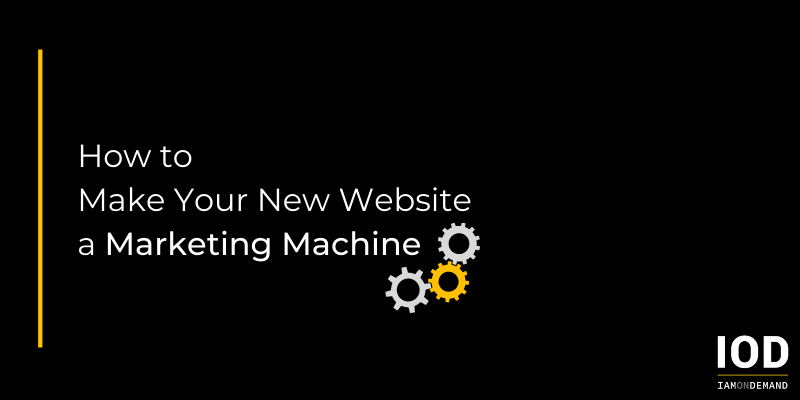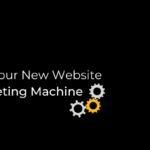Good content is central to creating a new website, but it isn’t the only thing you need. You should also think about what your goals are with the new site, your SEO strategy, how you’ll engage your visitors, and how you’ll make sure they become customers.
For many visitors, your website is the first impression of your brand. It conveys a lot about your company, giving insights into your professionalism, vision, and attention to detail.
Just as importantly, remember that a website is more than a collection of web pages. There should be consistency throughout, with a clear path that makes it intuitive for visitors to become customers.
There are many benefits to matching great content with an effective website. Let’s dive into exactly how to do that.
Building the Machine
There are hundreds of things you could focus on when building a new website. Keep the following in mind to take your site to the next level:
- Choose your messaging and tone.
- Study your competition.
- Highlight products and services.
- Know where content fits in your marketing funnel.
- Clearly mark next steps.
- Select SEO keywords.
- Write first, then design.
Now let’s discuss each of these tips in more detail.
Choose Your Messaging and Tone
Have you ever gotten in trouble, not for what you said, but how you said it? Words themselves are important, but tone of voice registers just as clearly. The same is true for a brand. As brilliant as your content might be, if the tone doesn’t connect with your target audience on an emotional level, you’re likely to lose their attention.
Are you a conversational brand or a bit more formal? Do you delve into tactical execution or position your brand as a thought leader?
Your style and tone of voice help communicate with your visitors, giving them a sense of familiarity. It’s important to listen closely to the audience you’d like to reach and then create a feeling on your site that resonates.
Study Your Competition
When thinking about the design and function of your new website, keep your competitors in mind. Established businesses often have enormous budgets for research and analysis, so there might be something to learn from their tactics.
Watching your competition will also help you differentiate your brand. When you study their websites, keep an eye on the following:
- Is the structure of the site easy to follow? Is it user friendly, with each page conveying information that customers in your industry would want to see?
- How does their messaging and tone compare to other competitors and your own expectations?
- What is the frequency of their content? If they have a blog or resource center, are they posting content regularly?
- What are your competitors listing as their strengths and unique selling propositions? Are there gaps in their capabilities where your business has an advantage? How can you show what makes your offering distinct?
People often like to weigh their options, so it’s very likely they’ll compare your site to the competition sooner or later. It’s important to highlight what makes you unique—not just in your style and tone, but also the specific problems you solve.
Highlight Products and Services
When it comes to deciding how your products or services will appear on your site, start with these three questions:
- Will your customers believe that you understand their concerns?
- Do your products and services clearly solve those problems?
- How will the customer feel after solving the problems with your help?
If your website can answer these three questions, it will shorten sales cycles considerably. One way to accomplish this is to use case studies and testimonials. Newer companies often feature client logos prominently, since it builds trust and ensures visitors know they’re in good company. If your business has partners or resellers, consider adding their testimonials to show that there is a robust ecosystem around your product and services.
A case study can be even more effective at building trust. It shows visitors that someone else faced a similar set of challenges, trusted your products to handle them, and felt great about it. What is more persuasive than that?
Your products and services should be clearly described on your site and easily reachable through a specific place in your website navigation. Blog posts and landing pages can go into detail about specific industry problems and link back to the core offerings.
In case the visitor isn’t ready to close a deal yet, make sure it’s simple to sign up for a demo, subscribe for updates, request a consultation or price quote, or start a free trial—depending on what fits your business best.
Content your tech audience wants. The results you need.

Know Where Content Fits in Your Marketing Funnel
It’s important to remember how visitors become customers. Every piece of content and every page has a role to play in that journey. If your content tries to convert first-time visitors to paying customers by the time they reach the end of the page, it’s attempting to do too much at once.
At the top of the marketing funnel, use thought-leadership content (such as white papers and articles) that offers helpful information about industry issues. This should be evergreen information that stays useful for a long time and demonstrates your company’s credibility, without trying to push any product.
Next, include consideration-phase content, which digs deeper into a specific challenge (e.g., guides or detailed case studies) before introducing your services as a unique solution.
Finally, near the end of the funnel, your content can focus on what the reader should know while conversing with your sales team (including data sheets, checklists, or fact sheets). This type of content helps convince prospects that your company is the right fit.
Clearly Mark Next Steps
Before your website can become a marketing machine, each web page and piece of content has to clearly indicate the next step you’d like the user to take.
If a visitor reaches the end of a page and the writing simply stops, that’s a cue to close the browser tab. Instead, include a button that encourages the reader to subscribe for more or share the article via email or social media. You can also add a module with a few related content pieces the reader might be interested in.
When you’re creating mid-funnel content that addresses a specific problem, it’s more appropriate to point the reader to a free trial or demo, or collect more details about their company size, industry, or use case.
Late-funnel content might end with a call-to-action to request a price quote or book a call with a sales representative.
Your process may look different than this—the key is to encourage visitors to continue along the customer journey.
Of course, the more you can use automation to connect these steps, the more effective your marketing machine will be. Email nurture campaigns or automated CRM tasks for the sales team, for example, can ensure the right piece of content appears in front of your leads at just the right time.
Select SEO Keywords
It’s hard to overstate the importance of search engine optimization (SEO) when creating website content. Knowing which keywords to focus on will help you create relevant content that drives the right audience to your site.
Where should you get started with keyword research? Researching your competitors can help. Find some of the common words and phrases on their websites and use tools like Answer the Public or Nibbs to find related ideas.
When you decide on the right set of keywords to target on your website, keep each topic page and blog post as focused as possible. Use links to connect closely related topics on your site into topic clusters, making sure both search engines and visitors can easily tell what your business is about.
Write First, Then Design
When you create your website plan, consider taking a content-first approach. Write out the important ideas that represent your core brand and connect with customers: keyword topics, products and services, and content that sends the right message at each stage of the buyer journey. Then focus on how your site’s visual design and navigation can best support your goals.
Once it’s clear how to clearly communicate your brand’s core messages and guide prospects along to becoming customers, your design templates will be easy to create. We recently worked on our own website with Design Studio GLD and followed a similar process.
Gilad Fried, the creative director, emphasized the importance of creating content first, so the designers have something to visualize. Fried told us designers need to know the audience’s level of expertise: “Knowing the level of expertise of the target audience affects how you present the content… are they tech professionals, are they marketers?”
Fried also highlighted methods for making content more dynamic and readable by adding visuals and using different layouts: “You can have the same content but presented in different ways. Certain content can be sliced differently to make it easier to digest.”
A Better Way to Build Your Site
At IOD, we believe that great content is the ticket to success for your business. Content creation is a long-term investment that can bring in steady, consistent income for years to come. When you create the content for your site, remember to avoid common mistakes and pitfalls, such as failing to package your content correctly, focusing on ineffective distribution channels, and assuming that distribution is marketing’s role alone. These can put you in a hole, making it difficult to continue building out your site.
Using the guidelines in this post will help you build a website with clear and relevant content that drives increasing traffic and inspires visitors to come back for more. Make sure you have the resources—both in-house and out—to build a marketing machine that delivers.








